Explore the core in new and interesting ways
This is an excerpt from Yoga Therapy by Kristen Butera,Staffan Elgelid.
Core Poses
You might hear a lot of talk these days about the importance of the core. "Core strength" and "core stability" are just a few of the common terms that you have probably heard at some point in your yoga and fitness journey. The interesting thing is, that for all of the dialogue, there still doesn't seem to be universal agreement about what the core is. If you read and study for long enough, you will notice the definition of "core" tends to change based on the training method that you are exploring. Depending on what your goals are, you will have different experiences of the core, some of them more helpful or effective than others.
In fitness culture, the core is often the subject of certain aesthetic standards that are focused on the external show of some of the more superficial muscles of the core, known to many as six-pack abs. In reality, the core is a complex set of muscles that goes beyond the six-pack aesthetic: Functional core stability includes strength, endurance, flexibility, and motor control. Our approach moves away from attempting to train isolated core muscles in a single, held position or in one particular pelvic position. Instead we emphasize the various muscles that surround the core, including the abdominals, obliques, erector spinae, glutes, and pelvic floor and ask that you integrate core awareness into your favorite activities. We also like to emphasize the diaphragm as part of the core and remind you that while the diaphragm is one of the primary muscles of respiration, it is also a deep-core stabilizer. Using the breath differentiation exercises in tandem with the various movements of the spine highlighted in the previous chapters has already given you options for exploring your core in new and interesting ways.

The muscles of the core.
Moving into this section, let's simplify the definition of the core as anything from below the end of the sternum and low borders of the rib cage to the base of the pelvis. This definition makes it easier to think about using yoga poses to make relevant connections from the upper and lower extremities into the core and explore different types of core activities in your yoga therapy practices. The next exploration revisits core activation as it relates to pelvic and spinal position along with basic pelvic floor and core activations. As always, variety is key.
Exploration
Core Activation
- Start in mountain pose. Place one hand on the abdomen and the other on the low back (a).

- Inhale to slowly roll the front of the pelvis toward the feet (anterior tilt), arching the low back (b). Exhale to roll the front of the pelvis toward the face (posterior tilt), flattening the lumbar curve (c). Notice how the tilt of the pelvis changes the sensation of the core muscles firing or not firing under your hands.


- Roll the pelvis again, but reverse the breathing pattern, exhaling into the anterior tilt and inhaling into the posterior tilt. What, if anything, changes for you in terms of awareness?
- Now move the pelvis and breathe at your natural rhythm, looking for equal muscular tension under both hands. When you find equal tension, you are approaching active neutral. Try to find a natural curve in the low back, where you are not overly arched or overly tucked.
- From active neutral, try drawing up on the muscles of the pelvic floor, as if you are trying to stop the flow of urine. Hold the contraction for 30 seconds as you continue to breathe in the abdomen and rib cage.
- Now try drawing up on the muscles of the pelvic floor, as if you are trying to stop yourself from passing gas. Hold the contraction for 30 seconds as you continue to breathe in the abdomen and rib cage.
- Draw up on both areas of the pelvic floor at the same time. Imagine zipping up into the low abdomen from the connection into the pelvic floor. Wrap that activity around to the low back. How does the awareness and core activation change as you make these new connections?
- Now try working with both relaxing and contracting your pelvic floor, playing with increments of activation. Try drawing up on the pelvic floor 25, 50, 75, and 100 percent. Reverse and try to relax the pelvic floor down from 100 to 75, 50, and 25 percent. Play with how much activation is too much or too little as it relates to your ability to breathe, stabilize your core without being rigid, or holding on to the pelvic floor too tightly.
- Now try steps 4 through 8 again, but with the spine in standing flexion (forward bend), extension (backbend), rotation (twist), and lateral flexion (side bend). How does your core awareness or activation change with the different positions of the spine?
Learn more about Yoga Therapy: A Personalized Approach for Your Active Lifestyle.
More Excerpts From Yoga TherapySHOP

Get the latest insights with regular newsletters, plus periodic product information and special insider offers.
JOIN NOW
Latest Posts
- Big problem verses small problem activity
- Combining creativity with a structured framework to create fun and effective games
- Designing games to allow all students to experience success
- Examples of TR sensory stimulation activities
- Therapeutic recreation tools of the trade
- The four steps in the therapeutic recreation process


